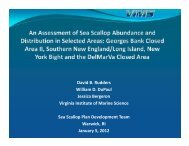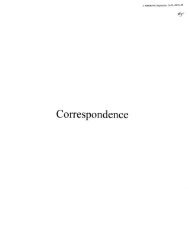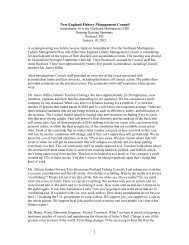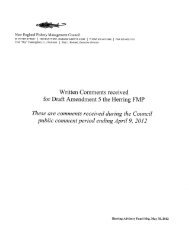Smooth Bottom Net Trawl Fishing Gear Effect on - New England ...
Smooth Bottom Net Trawl Fishing Gear Effect on - New England ...
Smooth Bottom Net Trawl Fishing Gear Effect on - New England ...
You also want an ePaper? Increase the reach of your titles
YUMPU automatically turns print PDFs into web optimized ePapers that Google loves.
NOAA/NMFS Unallied Science Project, Cooperative Agreement NA16FL2264 December 2005<br />
<str<strong>on</strong>g>Smooth</str<strong>on</strong>g> <str<strong>on</strong>g>Bottom</str<strong>on</strong>g> <str<strong>on</strong>g>Net</str<strong>on</strong>g> <str<strong>on</strong>g>Trawl</str<strong>on</strong>g> <str<strong>on</strong>g>Fishing</str<strong>on</strong>g> <str<strong>on</strong>g>Gear</str<strong>on</strong>g> <str<strong>on</strong>g>Effect</str<strong>on</strong>g> <strong>on</strong> the Seabed:<br />
Investigati<strong>on</strong> of Temporal and Cumulative <str<strong>on</strong>g>Effect</str<strong>on</strong>g>s BKAM/CR<br />
3.5.3 Evaluati<strong>on</strong> of <str<strong>on</strong>g>Trawl</str<strong>on</strong>g>ing <str<strong>on</strong>g>Effect</str<strong>on</strong>g>s in the Little Tow and Mud Hole Areas<br />
The results of the October REMOTS survey are summarized in Table 3.5-3 for the Little<br />
Tow stati<strong>on</strong>s and Table 3.5-4 for the Mud Hole stati<strong>on</strong>s. Likewise, the results for the<br />
November survey are summarized in Table 3.5-5 for the Little Tow stati<strong>on</strong>s and Table<br />
3.5-6 for the Mud Hole stati<strong>on</strong>s.<br />
Am<strong>on</strong>g the changes that might be expected to occur if trawling was physically disturbing<br />
the sediment surface are the following: 1) breaking up of the otherwise cohesive sediment<br />
particles that would be manifested in the sediment-profile images as a noticeable change<br />
in the sediment texture or fabric, 2) increase (or decrease) in the amount small-scale<br />
surface roughness, 3) a decrease in the RPD depth resulting from removal of the oxidized<br />
surface layer of sediment, 4) significant breakage or removal of delicate biological<br />
surface structures (e.g., polychaete tubes), and 5) c<strong>on</strong>sistent with 3 and 4, apparent<br />
changes in infaunal successi<strong>on</strong>al stage or OSI values.<br />
Overall, the images obtained in the both October and November post-trawl REMOTS<br />
surveys showed an absence of any significant trawling-induced changes in either physical<br />
or biological c<strong>on</strong>diti<strong>on</strong>s at the sediment-water interface. A statistical test for unplanned<br />
comparis<strong>on</strong>s am<strong>on</strong>g pairs of means (Games and Howell method at the 0.05 significance<br />
level, from Sokal and Rohlf (1981)) indicated no significant differences am<strong>on</strong>g surveys<br />
or stati<strong>on</strong> groups in the average boundary roughness, RPD, or OSI values shown in<br />
Tables 3.5-1 through 3.5-6. In other words, in any particular survey, there was no<br />
significant difference in each of these three parameters between the c<strong>on</strong>trol lane versus<br />
trawl lane stati<strong>on</strong>s. Likewise, there was no statistically significant change through time<br />
in each of these parameters at either the trawl or c<strong>on</strong>trol stati<strong>on</strong>s.<br />
Figures 3.5-3 through 3.5-7 present representative REMOTS images illustrating the<br />
absence of any detectable changes in sediment fine-scale characteristics, either through<br />
time or in terms of the “trawl versus c<strong>on</strong>trol” comparis<strong>on</strong>. In all cases, there were no<br />
obvious, c<strong>on</strong>sistent changes in the basic color, texture or fabric of the sediment surface<br />
that would otherwise indicate physical disturbance by trawling.<br />
The density of tube-building, Stage I polychaetes is a somewhat less reliable indicator of<br />
trawling disturbance than sediment texture or RPD depth, because populati<strong>on</strong>s of these<br />
opportunists are known to have c<strong>on</strong>siderable natural variati<strong>on</strong> in both space and time.<br />
Even if trawling was resulting in wholesale removal of these tubes across wide areas,<br />
these organisms are capable of re-establishing populati<strong>on</strong>s within days. In a few of the<br />
images, there were Stage I tubes that appeared to be lying flat (i.e., recumbent) <strong>on</strong> the<br />
sediment surface rather than in the more typical upright positi<strong>on</strong>, but there was no<br />
c<strong>on</strong>sistent pattern in the occurrence of these recumbent tubes between trawl versus<br />
c<strong>on</strong>trol stati<strong>on</strong>s to signal clearly a trawling effect. Although Stage I tubes are able to<br />
become quickly re-established following a physical seafloor disturbance, the persistence<br />
of these tubes through time together with the absence of any other indicators (e.g.,<br />
removal of the oxidized surface layer, changes in surface texture or microtopography)<br />
53







